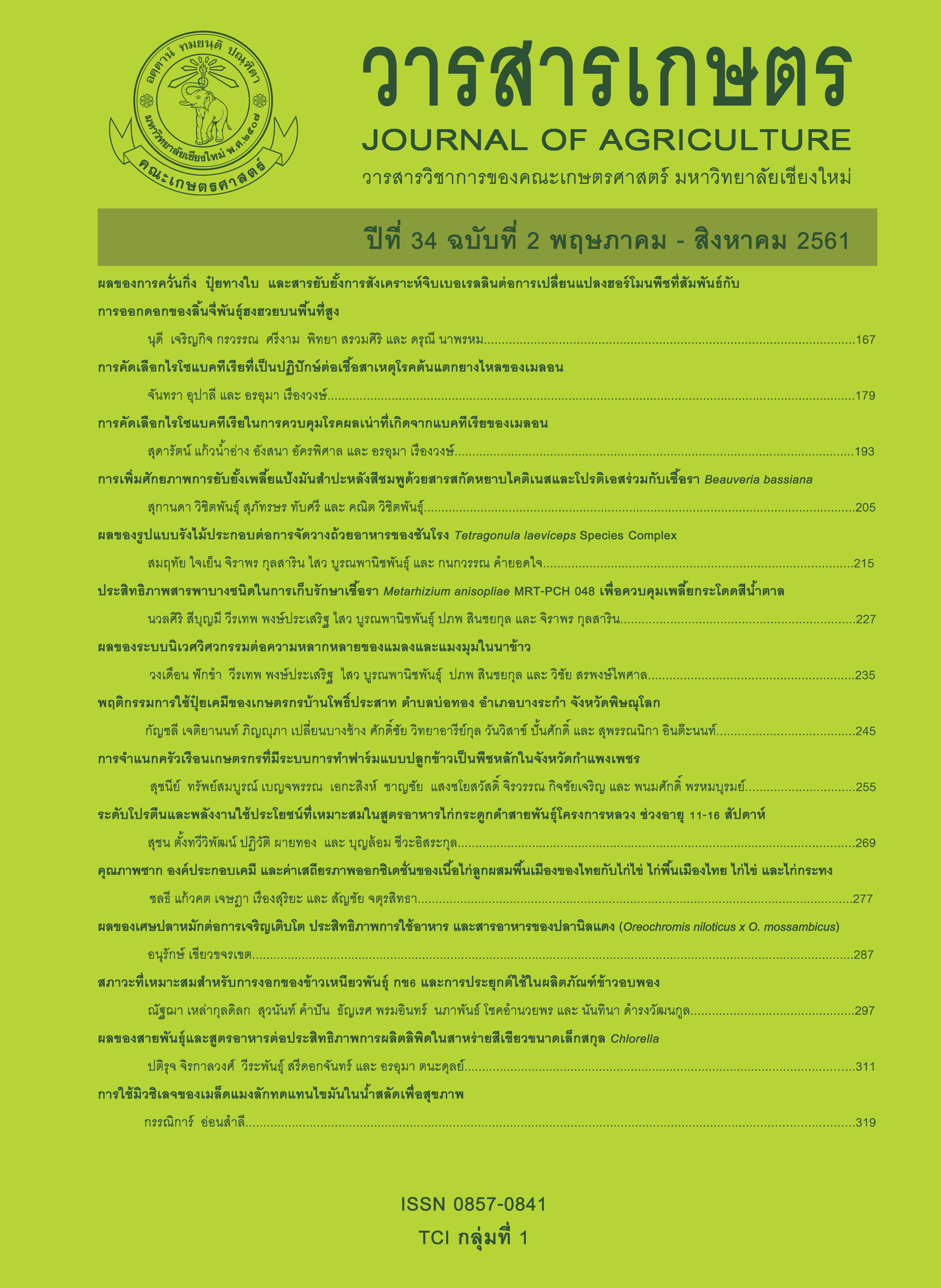การคัดเลือกไรโซแบคทีเรียในการควบคุมโรคผลเน่าที่เกิดจากแบคทีเรียของเมลอน
Main Article Content
บทคัดย่อ
การคัดเลือกไรโซแบคทีเรียปฏิปักษ์จากดินบริเวณรอบรากของเมลอน เพื่อใช้ในการควบคุมการเจริญของเชื้อแบคทีเรีย Acidovorax citrulli สาเหตุโรคผลเน่าของเมลอน สามารถแยกเชื้อได้ทั้งหมด 149 ไอโซเลท ด้วยวิธี soil dilution plate ซึ่ง 141 ไอโซเลท แยกจากแปลงเกษตรกรในตำบลบ้านเรือน อำเภอป่าซาง จังหวัดลำพูน และ 8 ไอโซเลท จากศูนย์วิจัย สาธิตและฝึกอบรมการเกษตรแม่เหียะ คณะเกษตรศาสตร์ มหาวิทยาลัยเชียงใหม่ การคัดเลือกไรโซแบคทีเรียปฏิปักษ์ด้วยวิธี paper disc diffusion พบว่า มี 4 ไอโซเลท ที่สามารถยับยั้งเชื้อสาเหตุโรคได้ ได้แก่ ไอโซเลท S93, S97, S125 และ S126 โดยมีบริเวณยับยั้งเท่ากับ 1.44, 1.36, 1.74 และ 0.86 เซนติเมตร ตามลำดับ เมื่อนำไรโซแบคทีเรียปฏิปักษ์ที่มีประสิทธิภาพดีที่สุดในสองลำดับแรกไปทดสอบการควบคุมโรคในโรงเรือนทดสอบ พบว่า ไอโซเลท S125 สามารถยับยั้งการเกิดโรคได้ร้อยละ 70.00 และไอโซเลท S93 สามารถยับยั้งการเกิดโรคได้ร้อยละ 63.33 เมื่อจัดจำแนกไรโซแบคทีเรียปฏิปักษ์ทั้ง 2 ไอโซเลท โดยอาศัยลักษณะทางสัณฐานวิทยาเบื้องต้น และการวิเคราะห์ลำดับนิวคลีโอไทด์บริเวณยีน 16S rDNA พบว่า ไอโซเลท S125 มีความเหมือนกับเชื้อแบคทีเรีย Pseudomonas monteilii ถึงร้อยละ 100 และ ไอโซเลท S93 มีความเหมือนกับเชื้อแบคทีเรีย Bacillus subtilis ถึงร้อยละ 99
Article Details
เอกสารอ้างอิง
กุศล ถมมา และ พิศาล ศิริธร. 2556. ชีวภัณฑ์เชื้อแบคทีเรียปฏิปักษ์ Bacillus subtilis B076 เพื่อการเคลือบเมล็ดและพ่นทางใบ เพื่อควบคุมเชื้อแบคทีเรีย Acidovorax avenae subsp. citrulli. แก่นเกษตร 41(ฉบับพิเศษ 1): 339-345.
เกวลิน คุณาศักดากุล และ ชัยพร ขัดสงคราม. 2555. การคัดเลือกเชื้อแอกติโนไมซีสเอนโดไฟต์ที่เป็นปฏิปักษ์ต่อเชื้อราสาเหตุโรคผลเน่าของลำไย. วารสารเกษตร 28(3): 285-294.
ปิยรัตน์ ธรรมกิจวัฒน์ ศรีสุข พูนผลกุล ณัฏฐิมา โฆษิต-เจริญกุล และ วงศ์ บุญสืบสกุล. 2553. การศึกษาประสิทธิภาพของสารเคมีในการกำจัดเชื้อ Acidovorax avenae subsp. citrulli กับเมล็ดพันธุ์พืชสกุลแตงบางชนิดเพื่อการส่งออก. หน้า 1377-1389. ใน: รายงานผลงานวิจัยประจําปี 2553 เล่มที่ 1. กลุ่มวิจัยการกักกันพืช สำนักวิจัยพัฒนาการอารักขาพืช กรมวิชาการเกษตร, กรุงเทพฯ.
อภิชาติ ศรีสะอาด และ สุธิพงศ์ ถิ่นเขาน้อย. 2558. เมลอน & แคนตาลูป เงินล้าน. นาคา อินเตอร์มีเดีย, กรุงเทพฯ. 136 หน้า.
อรอุมา เรืองวงษ์ และ เบญจวรรณ ใจจันทรา. 2560. การใช้แอคติโนมัยซีทจากดินเพื่อยับยั้งเชื้อแบคทีเรีย Ralstonia solanacearum สาเหตุโรคเหี่ยวเขียวของมะเขือเทศ. วารสารเกษตร 33(1): 49-59.
Burdman, S. and R. Walcott. 2012. Acidovorax citrulli: generating basic and applied knowledge to tackle a global threat to the cucurbit industry. Molecular Plant Pathology 13(8): 805-815.
Beveridge, T.J. 2001. Use of the gram stain in microbiology. Biotechnic and Histochemistry 76(3): 111-118.
Crall, J.M. and N.C. Schenck. 1969. Bacterial fruit rot of watermelon in Florida. Plant Disease Reporter 53: 74-75.
Drew, W.L., A.L. Barry, R. O'Toole and J.C. Sherris. 1972. Reliability of the Kirby-Bauer disc diffusion method for detecting methicillin-resistant strains of Staphylococcus aureus. Applied Microbiology 24(2): 240-247.
Frankle, W.G., D.L. Hopkins and R.E. Stall. 1993. Ingress of the watermelon fruit blotch bacterium into fruit. Plant Disease 77(11): 1090- 1092.
Kejela, T., V.R. Thakkar and R.R. Patel. 2017. A novel strain of Pseudomonas inhibits Colletotrichum gloeosporioides and Fusarium oxysporum infections and promotes germination of coffee. Rhizosphere 4: 9-15.
Kloepper, J.W., R.M. Zablotowick, E.M. Tipping and R. Lifshitz. 1991. Plant growth promotion mediated by bacterial rhizosphere colonizers. pp. 315-326. In: D.L. Keister and P.B. Cregan (eds.). The Rhizosphere and Plant Growth. Kluwer Academic Publishers, Dordrecht.
Medeiros, F.H.V., I.S.F. Moraes, E.B S. Neto, E.B. Silveira and R.L.R. Maria. 2009. Management of melon bacterial blotch by plant beneficial bacteria. Phytoparasitica 37(5): 453-460.
O’Brien, R.G. and H.L. Martin. 1999. Bacterial blotch of melons caused by strains of Acidovorax avenae subsp. citrulli. Australian Journal of Experimental Agriculture 39(4): 479-485.
Pandey, A., P. Trivedi, B. Kumar and L.M.S. Palni. 2006. Characterization of a phosphate solubilizing and antagonistic strain of Pseudomonas putida (B0) isolated from a sub-alpine location in the Indian Central Himalaya. Current Microbiology 53(2): 102-107.
Pinyapong, P.S. 1994. Etiology and factors affecting the development of fruit blotch of watermelon (Citrullus lanatus (Thunb.) Matsum and Nakai) in Northeastern Thailand. M.S. Thesis. University of the Philippines, Los Baños. 99 p.
Popovic, T. and Ž. Ivanovic. 2015. Occurrence of Acidovorax citrulli causing bacterial fruit blotch of watermelon in Serbia. Plant Disease 99(6): 886.
Rakh, R.R., L.S. Raut, S.M. Dalvi and A.V. Manwar. 2011. Biological control of Sclerotium rolfsii, causing stem rot of groundnut by Pseudomonas cf. monteilii 9. Recent Research in Science and Technology 3(3): 26-34.
Schaad, N.W., G. Sowell Jr., R.W. Goth, R.R. Colwell and R.E. Webb. 1978. Pseudomonas pseudoalcaligenes subsp. citrulli subsp. nov. International Journal of Systematic Bacteriology 28(1): 117-125.
Schaad, N.W., E. Postnikova, A. Sechler, L.E. Claflin, A.K. Vidaver, J.B. Jones, I. Agarkova, A. Ignatov, E. Dickstein and B.A. Ramundo. 2008. Reclassification of subspecies of Acidovorax avenae as A. avenae (Manns 1905) emend., A. cattleyae (Pavarino, 1911) comb. nov., A. citrulli Schaad et al., 1978) comb. nov., and proposal of A. oryzae sp. nov. Systematic and Applied Microbiology 31(6-8): 434-446.
Suslow, T.V., M.N. Schroth and M. Isaka. 1981. Application of a rapid method for gram differentiation of plant pathogenic and saprophytic bacteria without staining. Phytopathology 72(7): 917-918.
Trivedi, P., A. Pandey and L.M.S. Palni. 2008. In vitro evaluation of antagonistic properties of Pseudomonas corrugate. Microbiological Research 163(3): 329-336.
Vessey, J. K. 2003. Plant growth promoting rhizobacteria as biofertilizers. Plant and Soil 255(2): 571-586.
Wang, X., G. Li, D. Jiang and H.C. Huang. 2009. Screening of plant epiphytic yeasts for biocontrol of bacterial fruit blotch (Acidovorax avenae subsp. citrulli) of hami melon. Biological Control 50(2): 164-171.
Willems, A., M. Goor, S. Thielemans, M. Gillis, K. Kersters and J. De Ley. 1992. Transfer of several phytopathogenic Pseudomonas species to Acidovorax as Acidovorax avenae subsp. avenae subsp. nov., comb. nov., Acidovorax avenae subsp. citrulli, Acidovorax avenae subsp. cattleyae, and Acidovorax konjaci. International Journal of Systematic Bacteriology 42(1): 107-119.


